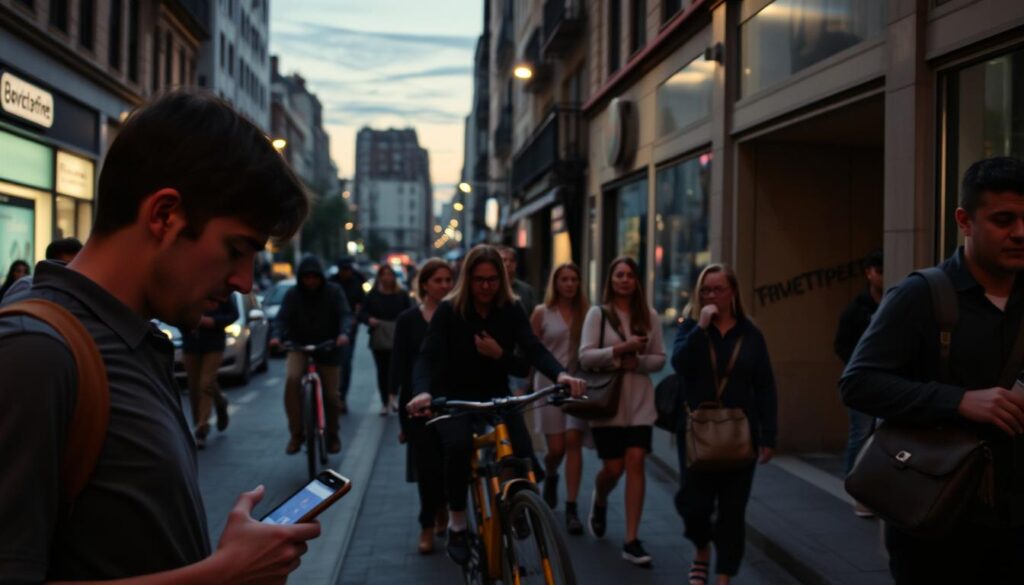As I go about my day, I’ve learned how key it is to know what’s around me. Being mindful of my environment keeps me safe and helps me act fast in emergencies.
Situational awareness means knowing and understanding what’s happening around you. It’s a skill you can get better at with practice. By watching out for dangers and staying alert, you can lower your chances of getting hurt.
For example, having the right emergency tools can make you more aware and quicker to react. This skill is important in many areas of life, like keeping safe at work or protecting yourself personally.
Key Takeaways
- Developing situational awareness can help prevent accidents and ensure safety.
- Being aware of one’s surroundings is critical in emergency situations.
- Proper training and equipment can enhance situational awareness.
- Situational awareness is essential in various aspects of life.
- Regular practice can improve situational awareness skills.
Understanding Situational Awareness
Situational awareness is about knowing what’s around you. It’s key in many parts of life.
Being aware lets you make smart choices and handle dangers or risks.
Definition of Situational Awareness
Situational awareness is about noticing what’s happening around you. It uses your senses to see your environment.
Importance in Daily Life
The benefits of situational awareness are many. It helps you avoid accidents and spot dangers.
For example, knowing your surroundings can help you see odd behavior or avoid risky places.
| Aspect | Description | Benefit |
|---|---|---|
| Perception | Noticing surroundings | Early detection of hazards |
| Comprehension | Understanding gathered information | Informed decisions |
| Projection | Predicting outcomes | Proactive safety |
The Three Levels of Situational Awareness
Situational awareness is more than one skill. It has three levels that help us stay safe. These levels are key to understanding how to stay safe in different places.
The three levels are Perception, Comprehension, and Projection. Each level builds on the last, making a complete framework for staying safe.
Perception
The first level, Perception, is about noticing important things around us. It’s about seeing our surroundings, spotting dangers, and using our senses. Good perception helps us find and react to hazards.
For example, noticing a strange person or a dangerous spot is thanks to good perception. Staying alert and aware of our area helps improve our perception.

Comprehension
The second level, Comprehension, is about understanding what we’ve noticed. It’s making sense of the data and seeing its importance. Comprehension helps us judge the value of what we’ve seen.
For instance, seeing a suspicious person as a real threat needs comprehension. It’s about analyzing what we’ve seen and its meaning. This level is key for making smart choices in a situation.
Projection
The third level, Projection, is about guessing what might happen next. It’s about foreseeing outcomes and planning ahead. Projection helps us act before things happen, keeping us safe.
By guessing what might happen, we can avoid risks. For example, if we see a threat, we can guess its actions and plan our response.
In summary, the three levels of situational awareness – Perception, Comprehension, and Projection – work together to keep us safe. By knowing and using these levels, we can get better at situational awareness techniques and benefit from situational awareness training.
- Perception: Detecting relevant information from our surroundings.
- Comprehension: Understanding the gathered information.
- Projection: Predicting future events based on current understanding.
How to Enhance My Situational Awareness Skills
Improving situational awareness requires using observation techniques and mindfulness. It’s key to stay aware of your surroundings to avoid criminal activity. Experts, like those at experts in the field, agree on this. By boosting your situational awareness, you can move safely in different places, whether at work or outdoors.
Observation Techniques
Observation is vital for situational awareness. It means using your senses to understand your environment. Good observation includes being alert to your surroundings, spotting odd things, and using all your senses to assess a situation.
- Focus on details like people, objects, and the environment.
- Watch for any changes or odd activities around you.
- Use your senses (sight, sound, smell, touch) to get a full picture.
Mindfulness Practices
Mindfulness is about being fully present and engaged. It’s a great way to improve situational awareness. Being more mindful helps you notice your surroundings better and react to threats.
- Meditation helps with focus and concentration.
- Doing activities that keep you present, like yoga or walking.
- Stay away from distractions, like turning off your phone or finding a quiet spot.
| Technique | Description | Benefit |
|---|---|---|
| Observation | Using senses to gather information | Improved awareness of surroundings |
| Mindfulness | Being fully present and engaged | Enhanced ability to respond to threats |
By adding observation techniques and mindfulness to your daily life, you can greatly improve your situational awareness. This leads to better safety and security in many areas of your life.
Common Situational Awareness Mistakes
To stay safe, it’s key to know the common mistakes that can hurt our situational awareness. Situational awareness means knowing what’s around us and the risks. But, some errors can really mess with this skill.
Distraction and Its Effects
Distractions are a big problem for situational awareness. When we’re distracted, we can’t see or understand what’s around us well. Common distractions include using mobile devices, talking to others, and getting lost in thought. To stay safe, we need to keep our eyes and mind on the task and our surroundings.
Overconfidence in Familiar Settings
Being too sure of ourselves, even in places we know well, is another big mistake. When we’re too comfortable, we might not watch out for dangers. It’s important to stay alert, even in places we know. We should always check our surroundings and be ready for surprises.
Things that can lower our situational awareness include rushing, being tired, feeling too comfortable, bad communication, distractions, daydreaming, losing focus, and feeling stressed. Knowing these can help us avoid them.

Situational Awareness in Different Environments
As we move through different places, it’s key to use situational awareness techniques. This skill changes based on where we are.
Being aware of our surroundings is vital in many places. This includes cities, nature, and work. Each place has its own challenges that need special ways to stay aware.
Urban Settings
In cities, there are lots of people and buildings. We need to be extra careful. Watching people and cars, knowing escape routes, and spotting odd behavior are important.
For example, using Google Maps helps us know the area better. It shows us what’s around, parking options, and landmarks. This can help us avoid getting lost or surprised.
Outdoor Adventures
Going on hikes or camping means knowing the outdoors. We need to watch for dangers like animals, steep areas, and weather.
Good situational awareness training teaches us to read nature, use a compass, and understand weather. These skills keep us safe in the wild.
Workplace Safety
At work, being aware helps avoid accidents and keeps everyone safe. We should know about dangers like machines, spills, or fires.
Training and drills help workers stay alert. They prepare us for emergencies.
| Environment | Situational Awareness Techniques | Benefits |
|---|---|---|
| Urban Settings | Observing traffic, recognizing suspicious behavior | Enhanced personal safety, reduced risk of crime |
| Outdoor Adventures | Reading natural signs, understanding weather patterns | Reduced risk of accidents, improved navigation |
| Workplace | Identifying possible dangers, taking part in safety drills | Preventing accidents, better emergency readiness |
By using situational awareness techniques for each place, we can stay safer and protect others too.
Tools and Resources for Improving Awareness
To get better at situational awareness, I can use many tools and resources. These include mobile apps that send alerts and training programs to help me stay safe. They are designed for different environments.
Apps for Real-Time Alerts
There are apps that send alerts about dangers or crimes near me. For example, apps like Citizen or Next Door show me what dangers are common in areas. These apps help me make smart choices about where I am.

- Real-time crime reporting
- Alerts for suspicious activities
- Community-driven safety initiatives
| App Name | Key Features | Platform |
|---|---|---|
| Citizen | Real-time crime reporting, Safety Checks | iOS, Android |
| Next Door | Neighborhood networking, Crime alerts | iOS, Android |
| bSafe | Personal safety alerts, GPS tracking | iOS, Android |
Training Programs
There are also training programs to boost my situational awareness. These include scenario-based training and workshops. They teach me to spot threats and respond well.
Training programs offer many benefits. They help me:
- Recognize threats better
- Respond more effectively
- Feel more confident in different places
By using these tools and resources, I can greatly improve my situational awareness. This makes me safer every day.
The Role of Training in Situational Awareness
Training is key to being aware of my surroundings. Through detailed training, I can boost my situational awareness skills. This lets me react better in many situations.
Good training for situational awareness mixes different techniques. It teaches people to be alert and spot dangers early.
Scenario-Based Training
Scenario-based training is very effective. It mimics real-life scenarios to practice responses. For example, Krav Maga Worldwide self-defense classes teach how to act in danger, keeping me safe.
- Improves reaction time and decision-making
- Enhances ability to assess and respond to threats
- Builds confidence in handling challenging situations
Workshops and Seminars
Workshops and seminars are also great for improving situational awareness. They let me learn from experts and get the latest safety tips. They include interactive parts that help me understand situational awareness better.
Some key benefits of situational awareness training are being more alert, making better decisions, and staying safer. By making training a regular part of my life, I can dodge dangers more easily.
In summary, training is essential for keeping situational awareness sharp. By using scenario-based training, workshops, and seminars, I can greatly improve my safety and response in different places.
Situational Awareness and Personal Safety
To stay safe, it’s key to develop situational awareness skills. These skills help you spot and handle threats. Knowing what’s around you is vital for safety. It lets you see dangers coming and act fast.
Being alert to small details around you is important. It’s about noticing things and using that info wisely. This means observing, understanding, and making smart choices based on what you see.
Recognizing Threats
Spotting threats is the first step to safety. You need to be watchful of your surroundings. This includes people, objects, and ways to get away. Knowing what’s a threat and spotting it early is key.
In crowded places, noticing odd behavior or left items is critical. It’s not just seeing these things. It’s understanding their danger to you.
Responding Effectively
After spotting a threat, you need to act right. This means being ready, knowing how to respond, and staying calm. The right action can save you from harm.
Training and practice are key to good response. Doing scenario training helps you react well in danger.
By improving situational awareness skills, you boost your safety. It’s a way to avoid dangers and handle them when they come.
Building a Situational Awareness Routine
Situational awareness is not just a skill, but a habit. It can be developed through regular practice. By adding situational awareness to your daily routine, you can better anticipate and respond to threats.
Daily Practices
Using your senses regularly can make them sharper. This helps you avoid dangerous situations. Simple habits like being aware of your surroundings and noticing changes can boost your situational awareness.
For example, when I walk, I watch the people around me. I also look for exits and entrances and stay alert for hazards. This keeps me ready for anything.
Reflection Techniques
Reflection is key to improving situational awareness. Taking time to think about your day can show you how to stay safer. It helps you learn from your experiences.
After a close call, I think about what happened and how I reacted. I also think about what I could have done differently. This helps me get better at handling similar situations.
To improve your situational awareness, look into training programs. They offer valuable insights and techniques to sharpen your skills.
The Future of Situational Awareness
Situational awareness is getting more important in our lives. New tech is making it better. For example, Google Maps gives us real-time views of streets. This helps us understand our surroundings and dangers.
Advancements in Surveillance Technology
New tech is coming to help us stay aware. Advanced surveillance systems can spot dangers and warn us. These tools help us react faster in different situations.
Artificial Intelligence in Situational Awareness
Artificial intelligence (AI) is key in the future of awareness. AI can quickly sort through lots of data. It gives us insights that improve our awareness skills.
For instance, AI can look at examples of awareness to find patterns. This helps us prepare for threats. By mixing new tech with training, we can stay safer and more aware.
FAQ
What is situational awareness?
Situational awareness means knowing what’s around you and understanding the situation. It’s about being ready for what might happen next. It also means watching out for dangers and taking steps to avoid them.
Why is situational awareness important in daily life?
It’s key to staying safe every day. It helps you spot dangers, make smart choices, and keep safe in many places. This includes cities, outdoors, and work.
What are the three levels of situational awareness?
There are three main levels. First, you gather info about your area. Then, you understand the situation. Lastly, you guess what might happen next.
How can I improve my situational awareness skills?
Improve by observing and being mindful. Practice noticing your surroundings. Also, try meditation to stay present.
What are some common mistakes that can compromise situational awareness?
Mistakes like getting distracted, feeling too sure of yourself, or getting too comfortable can hurt your awareness. These can make you less safe.
How can I stay safe in different environments?
Know the dangers in each place. In cities, watch out for cars and people. Outdoors, check the weather and terrain.
What tools and resources are available to enhance situational awareness?
Many tools help, like apps for alerts, training, and workshops. They teach you to stay alert and safe in many places.
How can training programs help improve situational awareness?
Programs like scenario training teach you to spot dangers and act right. They give you the skills to stay safe.
What is the relationship between situational awareness and personal safety?
Awareness and safety go hand in hand. Knowing your surroundings helps you see threats and act to protect yourself.
How can I build a situational awareness routine?
Start daily habits like being alert and reflect on your experiences. This helps you get better at staying safe.
What is the future of situational awareness?
The future will bring new tech, like AI, to help us stay aware. This could make staying safe even easier.



